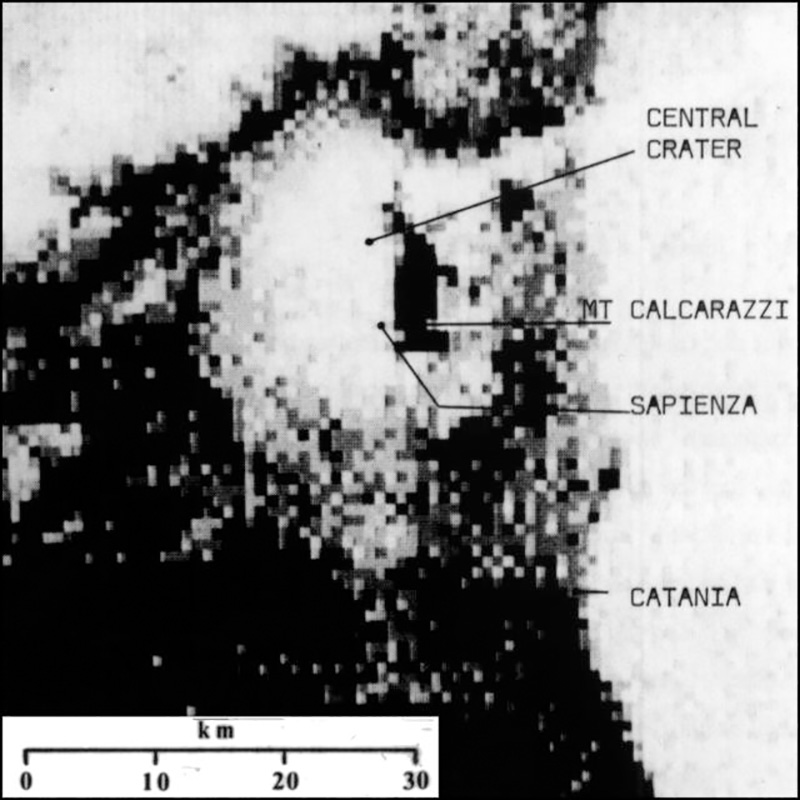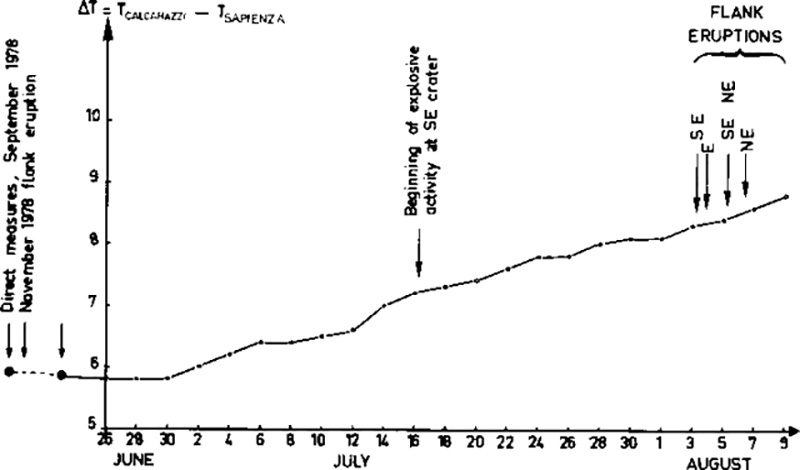Report on Etna (Italy) — October 1979
Scientific Event Alert Network Bulletin, vol. 4, no. 10 (October 1979)
Managing Editor: David Squires.
Etna (Italy) Thermal anomaly on SE flank
Please cite this report as:
Global Volcanism Program, 1979. Report on Etna (Italy) (Squires, D., ed.). Scientific Event Alert Network Bulletin, 4:10. Smithsonian Institution. https://doi.org/10.5479/si.GVP.SEAN197910-211060
Etna
Italy
37.748°N, 14.999°E; summit elev. 3357 m
All times are local (unless otherwise noted)
The following thermal anomaly report is from C. Archambault, J. Stoschek, and J. C. Tanguy.
"The existence of a N-S elongated thermal anomaly about 10 km has been determined on the upper half of Mount Etna, both by field measurements and infrared satellite imagery. It is believed that this high temperature anomaly is symptomatic of storage of magma at shallow depth within the rift zones of Etna. However, the magnitude of the thermal anomaly is expected to change with respect to volcanic activity (four flank eruptions have occurred from this zone during the past 2 years). Since 26 June, ground temperatures have been continuously recorded at the end of the thermal anomaly (figure 6). The results in this part of the volcano are considered the most significant because no volcanic activity has occurred in this zone for 70 years, therefore, the abnormal temperature cannot be due to cooling of residual magma. In order to eliminate the climatic effect, the data are presented (figure 7) as the difference between recordings of the central part of the thermal anomaly (Monte Calcarazzi Station) and those of a "reference station" (Sapienza) located at the same altitude about 1 km outside the anomalous zone.
 |
Figure 6. Infrared image taken 16 September 1978 by the NOAA 5 weather satellite. The thermal anomaly is shown by the dark area around Monte Calcarazzi. |
 |
Figure 7. Graph showing the variation between temperatures recorded at Monte Calcarazzi and Sapienza, September 1978-9 August 1979. |
"There had been considerable temperature increase (3°C) at the Monte Calcarazzi station during the month that preceded the flank eruption of 3 August. On 10 August the temperature at 120 cm depth, checked by direct measurements, was 9°C higher than the normal (Sapienza). Such a variation may be either a transient response to the August eruptive phenomena on the SE, E, and NE flanks, or the indication of magma motion southward - a problem that should be solved in the months to come.
References. Mise en évidence de zones thermiquement anormales sur le massif de l'Etna. 7éme R. ann. Sci. Terre, Lyon, Avril 1979, p. 15.
Mise en évidence d'anomalies thermiques dans la basse zone du secteur Sud de l'Etna, Note technique CNET 110/79.
Etablissement d'une carte thermique du massif de l'Etna à partir des données transmises par le satellite météorologique NOAA V...: Note technique CNET 111/79.
Further Reference. Guest, J.E., and Murray, J.B., 1980, Summary of volcanic activity on Etna, 1977-1979, in Huntingdon, E.T., et al., eds., 1980, U.K. Research on Mt. Etna: Royal Society of London, p. 50-52.
Geological Summary. Mount Etna, towering above Catania on the island of Sicily, has one of the world's longest documented records of volcanism, dating back to 1500 BCE. Historical lava flows of basaltic composition cover much of the surface of this massive volcano, whose edifice is the highest and most voluminous in Italy. The Mongibello stratovolcano, truncated by several small calderas, was constructed during the late Pleistocene and Holocene over an older shield volcano. The most prominent morphological feature of Etna is the Valle del Bove, a 5 x 10 km caldera open to the east. Two styles of eruptive activity typically occur, sometimes simultaneously. Persistent explosive eruptions, sometimes with minor lava emissions, take place from one or more summit craters. Flank vents, typically with higher effusion rates, are less frequently active and originate from fissures that open progressively downward from near the summit (usually accompanied by Strombolian eruptions at the upper end). Cinder cones are commonly constructed over the vents of lower-flank lava flows. Lava flows extend to the foot of the volcano on all sides and have reached the sea over a broad area on the SE flank.
Information Contacts: C. Archambault and J. Stoschek, CNET, France; J. Tanguy, Univ. de Paris VI; PIRPSEF, CNRS-INAG.

